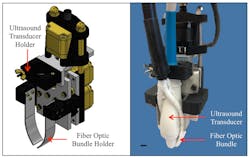New Biomedical Imager Combines Optical and Ultrasound Technologies
Purdue University researchers are developing a new biomedical method, photoacoustic tomography, that combines optical and ultrasound technology to improve diagnosis of diseases. It is a noninvasive technique that converts absorbed optical energy into acoustic signals. Pulsed light gets sent into body tissue, creating a small increase in temperature that causes tissues to expand and generate an acoustic response that can be “heard” by an ultrasound transducer. The ultrasound data then is used to build an image of the tissues.
The device provides real-time compositional information of body tissue without the need for contrast agents, and with better depth penetration compared with conventional optical techniques. It also provides information about where blood and lipid are located, along with other information.
Purdue University researchers are developing a novel biomedical imaging system that combines optical and ultrasound technology to improve diagnosis of life-threatening diseases. The researchers have created a motorized photoacoustic holder that allows users to easily maneuver the fiber optic bundles to tune the depth where light is focused, improving the light penetration depth and signal-to-noise ratio of the images.
The technique can detect and monitor various diseases, including cardiovascular disease, diabetes, and cancer. Those are ailments that the Centers for Disease Control and Prevention lists as among the most common, costly, and preventable of all health problems. Heart disease and cancer each account for one in every four deaths a year in the United States, and more than 30 million Americans, or more than 9% of the population, have diabetes. The cost of those three diseases a year in the United States is more than $718 billion a year, according to the CDC.
“That means there will be a great need for medical imaging. Trying to diagnose these diseases at an earlier time can lead to improved patient care,” says a Purdue researcher, Craig Goergen. “We are now trying to use this approach in a variety of different cases to see what it can do.”
This image shows how dual-modality ultrasound and photoacoustic tomography can “see” structural information such as blood vessels, in addition to compositional information such as fat deposition.
Among other potential uses for photoacoustic tomography is mapping of lipid deposition within an arterial wall that can cause other health problems, and measuring cardiac tissue damage and tumor biopsies. Using photoacoustic tomography for intraoperative tumor biopsies could help surgeons ensure they remove all the cancer from a patient.
Among the challenges posed by photoacoustic tomography were improving the penetration depth and signal-to-noise ratio. Researchers thought developing optical manipulation techniques to maximize photon density could solve those problems. As a result, they built a motorized holder that lets medical technicians easily aim the device and tune the depth where light will focus.



